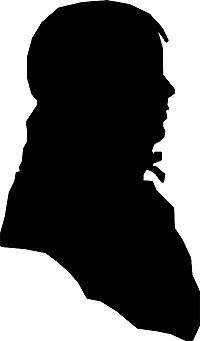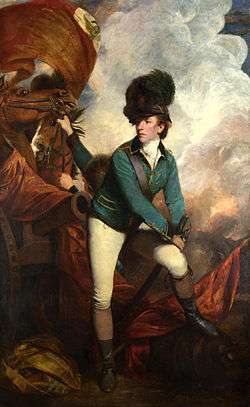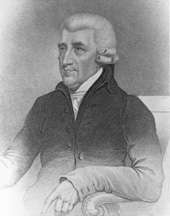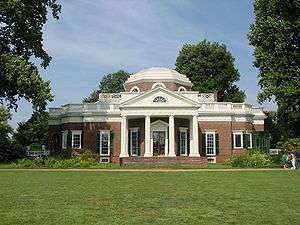Jack Jouett

John "Jack" Jouett, Jr. (December 7, 1754 – March 1, 1822) was a politician and a hero of the American Revolution, known as the "Paul Revere of the South" for his late night ride to warn Thomas Jefferson, then the governor of Virginia, and the Virginia legislature of the approach of British cavalry, who had been sent to capture them. Jouett was also the father of Matthew Harris Jouett, a famous painter from Kentucky.
The Jouett family and the revolution
Jack Jouett served as a captain in the 16th Regiment of the Virginia militia during the American Revolutionary War. He was of an old Norman family of Huguenot origin settled in Touraine, and directly descended from the noble Matthieu de Jouhet, Master of the Horse to Louis XIII of France, [1] [2][3] Lord of Leveignac, and a lieutenant in the Marshalsea of Limousin, whose grandson, Daniel de Jouet, went to the Narragansett country, in Rhode Island, in 1686. Daniel's youngest son, Jean, Jack's grandfather, settled in Virginia.[4]
Jouett, who stood 6 ft 4 in (1.93 m) tall and weighed 220 lb (100 kg), was a physically imposing figure, and contemporary accounts describe him as muscular and handsome.[5] His family, based in Albemarle County, Virginia, was very active in the revolutionary cause. Both Jouett and his father, John Sr., had signed the Albemarle Declaration, a document renouncing King George III that was signed by 202 Albemarle citizens. During the Revolution, Jouett's father supplied the military with meat for its rations and Jouett's three brothers all served in the military, including one who was killed at the Battle of Brandywine.[6]
Jack Jouett's ride
Background: the British plan

On June 1, 1781 British General Cornwallis learned from a captured dispatch that Governor Thomas Jefferson and Virginia's legislature had fled to Charlottesville, Virginia,[7] the location of Jefferson's home, Monticello. Members of Virginia's government had escaped to Charlottesville after Benedict Arnold, who had defected to the British, attacked Virginia's capital, Richmond. Cornwallis ordered Lieutenant Colonel Banastre Tarleton to ride to Charlottesville, Virginia, and capture Governor Jefferson and the Virginia legislature. Tarleton hoped to capture Jefferson and the many notable revolutionary leaders who were Virginia legislators, including: Patrick Henry, Richard Henry Lee, Thomas Nelson, Jr., and Benjamin Harrison V.[8]
On June 3, Tarleton left Cornwallis's camp on the North Anna River[7] with 180 cavalrymen and 70 mounted infantry of the Royal Welsh Fusiliers. Tarleton marched his force covertly and planned to cover the last 70 miles to Charlottesville in 24 hours, an incredibly fast maneuver designed to catch the politicians completely unaware.[8]
The ride begins
Jouett, twenty-seven years old, lay asleep on the lawn of the Cuckoo Tavern (although an account by Thomas Jefferson says Jouett was at his father's house) in Louisa County, Virginia, on the night of June 3, 1781.[6] During the night, he heard the sound of approaching cavalry and spotted the "White Coats," the British cavalry led by Colonel Tarleton.[6]
Jouett correctly suspected that the cavalry was marching to Charlottesville to capture the members of Virginia's government. Jouett knew that the legislature was completely undefended. Very little fighting had taken place on Virginia soil from 1776 to 1780, so most of Virginia's forces were deployed elsewhere. The British had only recently begun significant campaigns in Virginia, so few forces were in the state except a small group led by the Marquis de Lafayette, who was far from Charlottesville. With no possibility of defense, the only hope for Jefferson and the legislators was advance warning and escape. Jouett quickly mounted his horse and, at about 10 P.M., began the 40-mile ride from Louisa to Charlottesville. With the British cavalry on the main highway, Jouett had to take the rough backwoods trails to the overgrown Old Mountain Road with perhaps, only the light of the full moon to guide him and still ride quickly enough to beat the British.[6]
Tarleton's travels

At 11 P.M., Tarleton paused for a three-hour rest at Louisa Courthouse. He began his march again at about 2 A.M. He soon encountered a train of 11 supply wagons at Boswell's Tavern bound for South Carolina where Nathanael Greene led the main branch of the Continental Army in the South. Tarleton burnt the wagons and continued onward.
Around dawn, Tarleton reached the plantations of Castle Hill, Doctor Thomas Walker's home, and a splinter group of British arrived at Belvoir, the home of his son, Continental Congress member John Walker. Tarleton captured or paroled various important figures at the two plantations. Various legends have sprung up about the stop at Castle Hill. Supposedly, Dr. Walker prepared an elaborate breakfast (including alcohol), for Tarleton in order to allow more time for Jefferson and the legislature to get warning of the cavalry. Tarleton's account says he did pause at Castle Hill for a half-hour rest, but the story of Walker's ploy is probably apocryphal.[6]
Jouett's warning and Monticello

Jouett's route took him through a ford of the Rivanna River at the town of Milton. At about 4:30 A.M., he crossed the ford and ascended the mountain on which Jefferson's Monticello sits. At Monticello, Jouett awoke Jefferson and his guests, several Virginia legislators. According to the Giannini family, descendants of Jefferson's gardener, Anthony Giannini, noted early riser Jefferson was in the gardens at Monticello with their ancestor when Jouett arrived. Jefferson rewarded Jouett with some fine Madeira. Jouett then left to travel the additional two miles to warn those in the town of Charlottesville.
Jefferson did not rush. He had breakfast with the legislators and began making arrangements to leave. He spent two hours gathering his papers together. When Captain Christopher Hudson rode to Monticello to warn of the imminent arrival of the British, Jefferson sent his family to Enniscorthy, a friend's estate about 14 miles away. He continued his preparations to leave, setting a horse outside his estate for a quick escape. He continually checked Charlottesville with his telescope for signs of the British. By the time he finally saw them, cavalry were already on Monticello's lawn. He quickly mounted his horse and escaped, successfully eluding the British in the woods.[6] Oral testimony among one enslaved Monticello family indicated that Jefferson "hid in the hollow of an old tree" on nearby Carter's Mountain.[9]
The British detachment sent to Monticello was led by Captain Kenneth McLeod.[7] Upon their arrival, the British found Jefferson's slaves hurriedly hiding his valuables.
Jouett and Charlottesville

After leaving Monticello, Jouett rode to the Swan Tavern (owned by Jouett's father) where most of the legislators were staying. The legislators decided to flee and reconvene in Staunton, 35 miles west, in three days, on June 7. Jouett's warning allowed most legislators to escape, however, seven were caught.
Jouett also helped General Edward Stevens escape. The general was recovering from wounds he received at the Battle of Guilford Courthouse. From Swan Tavern, Jouett rode with General Stevens as he made his escape, but the wounded Stevens could not ride quickly enough to keep the British from catching up.[10] Fortunately, Jouett had the eccentric habit of dressing in ornate military costume with a scarlet coat and a plumed hat and Stevens was dressed in shoddy clothing. British cavalry assumed that Jouett must be a high military officer, so they ignored the shabby general, and pursued Jouett, who successfully eluded them.[6]
Aftermath and honors
In Staunton, the legislature elected Thomas Nelson as the next governor. Jefferson's term had expired on June 2.[7]
Recognizing its debt to Jouett, the legislature passed a resolution on June 15 to honor him. The legislature resolved to give Jouett a pair of pistols and a sword in gratitude. Jouett received the pistols in 1783, but it took 20 years before he got the promised sword.
Later life
In 1782, Jouett moved to what now is Kentucky. A family story says that, on his way to Kentucky, Jouett heard a woman's screams coming from a house. He burst into the house and found a wife being abused by her husband. He attempted to help by knocking down the husband, but the wife did not appreciate his involvement and struck him over the head with a pot. The pot's bottom gave out, and the pot became stuck around Jouett's neck. Jouett fled the scene and traveled 35 miles before he found a blacksmith to remove the pot.[6]
Jouett moved to Mercer County. He served as a Virginia state legislator and, when Kentucky became an independent state, a Kentucky state legislator from Mercer. Jouett was a prominent citizen of Kentucky. He had friendships with Andrew Jackson and Henry Clay. In business, he focused on livestock raising and breeding, importing animals from England.[6]
While in Mercer, Jouett married Sallie Robard. Together they had 12 children, including the famous painter Matthew Harris Jouett. Of his famous son Jouett said, "I sent Matthew to college to make a gentleman of him, and he has turned out to be nothing but a damned sign painter."[6] Jouett had another notable descendant through Matthew, his grandson James Edward "Fighting Jim" Jouett. James served under Admiral Farragut, and was immortalized in Farragut's famous quote "Damn the torpedoes! Four bells! Captain Drayton go ahead! Jouett full speed!"[6]
Jouett settled in Woodford County after leaving Mercer County. They moved to Woodford County when Matthew was a young boy. He built a house there in 1797. This house was built in style of the traditional hall and parlor plan, and was erected during the mid-Federal period, five years after Kentucky statehood, and features five rooms -- three downstairs and two half-story bedrooms upstairs.[11]It is not known when they left Woodford County to return to Mercer, but likely before the Census of 1810, as his name does not appear in that census. He later moved to Bath County.[12]
Jack Jouett died March 1, 1822 at his daughter's house in Bath County, Kentucky.[5] He is buried in Bath County at the "Peeled Oak" farm in an unmarked grave. The site of the grave was lost until the twentieth century.[6]
Legacy
Jack Jouett has, for the most part, fallen through the cracks of history on a national level. Jouett has retained some recognition locally, including Jouett Elementary School in Louisa County, Virginia and Jack Jouett Middle School in Albemarle County named in his honor. Many contend that his ride was far more important than that of Paul Revere, however, Revere's ride had the benefit of Henry Wadsworth Longfellow's poem to enshrine it in the American consciousness.
The Three Notch'd Brewing Company in Charlottesville named their flagship IPA in honor of Jouett's ride, calling it 40 Mile.[13]
In an attempt to promote Jouett's memory, the Charlottesville Daily Press published the following poem on October 26, 1909:
Hearken good people: awhile abide
And hear of stout Jack Jouetts ride;
How he rushed his steed, nor stopped nor stayed
Till he warned the people of Tarleton's raid.
The moment his warning note was rehearsed
The State Assembly was quickly dispersed.
In their haste to escape, they did not stop
Until they had crossed the mountain top.
And upon the other side come down.
To resume their sessions in Staunton Town.
His parting steed he spurred,
In haste to carry the warning
To that greatest statesman of any age,
The Immortal Monticello Sage.
Here goes to thee, Jack Jouett!
Lord keep thy memory green;
You made the greatest ride, sir,
That ever yet was seen.[1]
- ^ "When Jouett Rode to Save Jefferson". Richmond Then and Now. (Original publisher: Richmond Times-Dispatch 12/02/1934). Retrieved November 30, 2011.
Notes
- ↑ Price, Samuel Woodson (1902). The Old Masters of the Bluegrass: Jouett, Bush, Grimes, Frazer, Morgan, Hart. J. P. Morton & COmpany. p. 8.
- ↑ Jonas, Edward Asher. Matthew Harris Jouett, Kentucky portrait painter (1787-1827). The J. B. Speed Memorial Museum, 1938.
- ↑ Daughters of the American Revolution magazine. Volume 64, R.R. Bowker Co., 1930.
- ↑ Hart, Charles Henry. "Kentucky's Master Painter". Harper's magazine, Volume 98: December 1898 – May 1899. Making of America Project. 1899.
- 1 2 Moran, Donald Norman. "Jack Jouett of Virginia, the 'Other Ride'". AmericanRevolution.Org (originally published in "The Valley Compatriot", 1984). Retrieved October 30, 2011.
- 1 2 3 4 5 6 7 8 9 10 11 12 Dabney, Virginius (December 1961). "Jack Jouett's Ride". American Heritage. 13 (1).
- 1 2 3 4 "Jack Jouett's Ride (Teachers Guide)". History Happens. Electron Farm Publications. Retrieved November 30, 2011.
- 1 2 Dabney, Virginius (December 1961). "Jack Jouett's Ride". American Heritage (magazine). 13 (1). Retrieved February 10, 2016.
- ↑ Fossett, Peter H. "Once The Slave of Thomas Jefferson," Cincinnati Sunday World, January 20, 1898, repr. at PBS Frontline. ""
- ↑
- ↑ "About Us". Jack Jouett House Historic Site. Retrieved 27 July 2016.
- ↑ Railey, William (2002) [First published 1938]. History of Woodford County, Kentucky. Clearfield (Genealogical Publishing). p. 392. ISBN 9780806379999. Retrieved 26 July 2016.
- ↑ ""40 Mile" IPA - Three Notch'd". Three Notch'd.
References
- Jack Jouett House Historic Site, Versailles, KY
- A teacher's guide on Jouett
- Old Newspaper Article - "When Jouett Rode to Save Jefferson." Richmond Times-Dispatch. December 2, 1934.
- History Magazine Article Jack Jouett of Virginia: the "Other Ride." Reprint from "The Valley Compatriot." February, 1984. Donald Norman Moran, ed. americanrevolution.org.
- History Article, by Virginius Dabney "Jack Jouett's Ride." American Heritage Magazine. December 1961. Volume 13, Issue 1.
- To Disturb the Assembly: Tarleton's Charlottesville Raid and the British Invasion of Virginia, 1781 Maass, John R.. "To Disturb the Assembly: Tarleton's Charlottesville Raid and the British Invasion of Virginia, 1781.". Virginia Cavalcade, Autumn 2000. Republished at "A Student of History" website by Dr. John Maass, PhD.
External links
- Song about Jouett (with background)
- Jefferson's diary account on Jouett's ride and Tarleton's attack on Charlottesville